
Submarines of the United States in The Pacific War
| "Only in attack does a submarine reveal herself, before creeping away to the concealment of the deep" - Winston Churchill |
Make a Donation? |
 SS199 - Tautog |
Around about 1996, I bought a submarine simulation 'game' for my pc, and it was my favourite of all PC 'games'. It was called Silent Hunter and I sailed those US submarines all over the Pacific searching for Japanese ships. I had survived about 10 WW2's in all! My best WW2 career saw me haul in over 4.5m tons of ships! AND I had it on realistic too! I deliberately picked out only the 18000 ton tankers and the 15000 merchantmen. Plus a few battleships and carriers that I met in harbour's along the way. Sadly, Silent Hunter has now gone to the depths of non-conformity with Windows and is consigned to the deep. Then in early 2008 I got hold of Silent Hunter 4, amazing graphics and I was back on the high seas, commanding a US submarine. I decided a long time ago to do a tribute to the heroic men who sailed under the waves in those "pig boats" of which approximately 3500 did not return. These pages are a result of that. The USS Bowfin, which I actually "commanded on my computer", has her own web site - linked below and on my links page. If the submarine had been equipped correctly and used to their full effectiveness, I believe that the Pacific war would have been over possibly a year early. |
| These pages are a tribute to the men who served aboard these fine boats. I do not include many of the Commanders who sailed desks out of Brisbane, Fremantle, Manila, Midway or Pearl. Some of whom actually caused a lengthening of the conflict by their sheer bloody mindedness. One in particular stands out - Admiral English. His submarine commanders were relating to him for many months about the sad and sorry state of the Mk14 torpedo and the magnetic detonator which did not work. His insistence placed many sailors unnecessarily in "harms way" by insisting they fire useless torpedoes at an enemy that was then alerted to their presence. He blamed skippers and torpedo men alike, in fact everything except the real reason. In the early part of the war, these fleet commanders etc were people who had in most cases never even sailed a submarine, let alone in conflict. Many brave skippers lost their commands thanks to people like Admiral English. Interdepartmental squabbles were also not unknown. Failure to convey "Ultra" information to the correct desk meant that some people who needed to know information did not learn anything. Ultra was the breaking of the Japanese naval codes. Only a select few had access, even the President was taken off the list at one stage due to an Ultra message being found in a litter bin at the White House. | Many
skippers were sent to the wrong location or to the correct location but
too late. Submarines were concentrated in entirely the wrong areas,
prone to heavy defence and ASW. Routes were known but subs were not
correctly positioned to be of any effect. Submarines patrolling the deep
sea shipping lanes would have had far more effect than patrolling
heavily defended coastal areas, sometimes in waters unsuited to the
submarine. It was widely believed that the submarines should have been
concentrated in "empire waters" - around the coast of Japan, in deep
waters, the pickings would have been rich. I got a mail from someone in Florida whose father served on the Tautog as Torpedoman. It was quite complimentary. To him and to our other American allies brave hero's, this section is my tribute.............. |
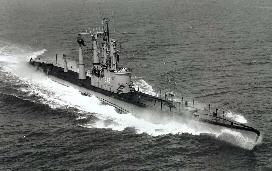 USS Burrfish |
The United States Submarine Service in WW II saw action in both the Atlantic, in a very limited way, and in the Pacific in a major way. The Submarine Service accounted for about 55% of all Japanese tonnage sunk in the war. This was done by a branch of the Navy that accounted for about 1.6% of the Navy's wartime complement. The Japanese lost 1,178 Merchant Ships sunk for a tonnage total of 5,053,491 tons. The Navel losses were 214 ships and submarines totalling 577,626 tons. A staggering five million, six hundred thirty one thousand, one hundred and seventeen tons, (5,631,117 tons), 1,392 ships. Japan ended the war with a bare 12% of her merchant fleet intact but not fuel at hand to run more than a few of them. Action in the Atlantic showed far fewer successes, mainly due to poor torpedo performance. By May of 1943 US submarine involvement had almost ceased in the Atlantic except for training and sea trials of new subs. US submarine losses in the Atlantic were few and may have been the result of an aggressive anti-submarine program by US and allied powers. The U.S. Navy lost 52 submarines sunk and 3617 men died in those boats. Their final resting place, and the circumstances surrounding their fate is, for the most part, unknown. The Submarine Service, refer to these boats and men as being on eternal patrol. Brave men all. |
| After the attack on Pearl Harbour where the greater part of the U.S. capital fleet had been damaged or destroyed, the only means of carrying the war to the Japanese was our submarines. Only five boats had been in port and the sub base was untouched in the attack. Six boats were in port on the west coast having work done or doing training exercises. The rest were either out on patrol or were in transit to Pearl Harbour when the attack happened. |
 |
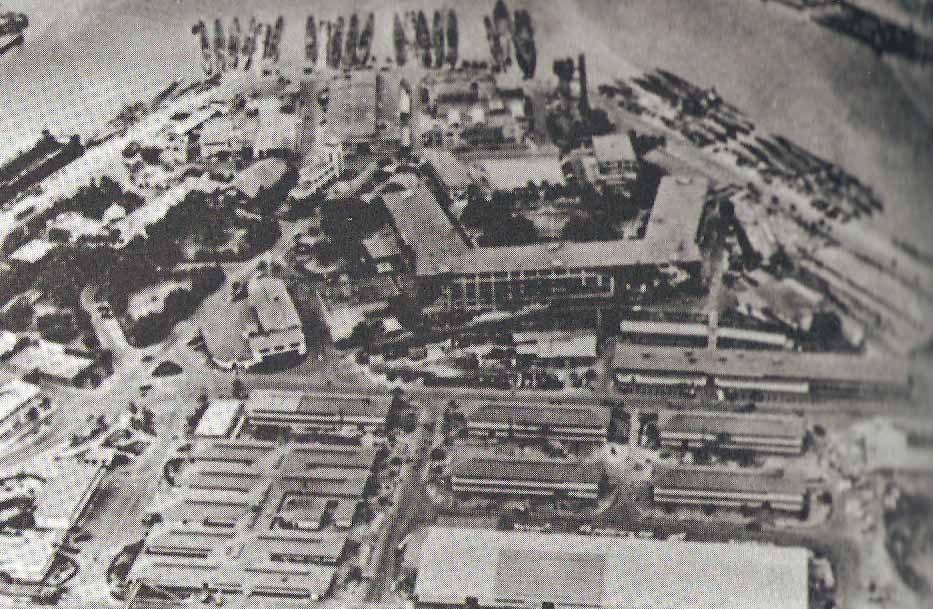 US Subs at Pearl Harbour |
On the afternoon of December 7, 1941 the order was issued by the Chief of Naval Operations to: "EXECUTE UNRESTRICTED AIR AND SUBMARINE WARFARE AGAINST JAPAN". These pages are about the results of that order! |
| After the war the Joint Army-Navy Assessment Committee went through all the Japanese and American records and sought out confirmation of sinkings. This has raised some dispute in Submarine circles since their logbooks show sinkings and tonnage that can not be confirmed by independent sources. Over estimating tonnage was common but not done on purpose. It is tough to guess if a ship is 9000 tons or 6000 tons from 1500 yards and an elevation of 6 inches above the water in the middle of the night while the enemy is trying to sink you. Sometime subs needed to take evasive action before seeing the ship sink. It might have been towed to safety and salvaged or managed to get back underway and leave the area of the sub. From the beginning of the war to the fall of Java, US submarines fired about 300 torpedoes and America claimed 36 ships sunk from 136 attacks. In reality this was only 10 ships sunk. For every ship sunk, US submarines fired approx 30 torpedoes! |
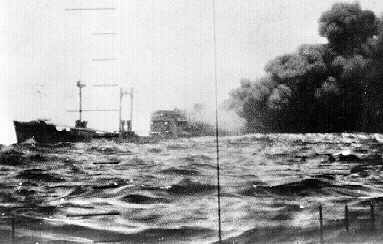 |
|
In December 2009, I received an interesting email from James Chavis, read it for yourselves and hopefully the correct figures can be relayed to me? The JANAC Report (Joint Army Navy Committee) was established following the war and drew conclusions from mostly blue skies. The commission contained officers, well meaning. No Submarine Officers were involved.. Their records were compiled from various post war data including Army, Air force, and erroneous Japans records which were known to be corrupt due to the severe losses suffered and the effect on morale. My Boat, the USS Pintado, as an example; was credited with 8 ships sunk in the JANAC Report while the record, which I can confirm by articles contained in the Presidential Unit Citation with Bronze Star our Boat received plus the fact I was an eye and ear (Sonar) witness to the sinking's on patrols 2 and 3. Total 9. 4 ships were accounted for on patrol 1 as witnessed by a Commodore who accompanied our Boat. Total 13 not 8. A major defense as it puts Pintado in the top echelon of ships sunk and damaged. I know on a historic matter of this nature that you want to maintain its reputation for accuracy and I can accommodate you in this regard. Remember, the JANAC Report is incorrect and unreliable and your site will carry this information long into the future after our remaining Crew are deceased. I am 84 now and one of the younger Sailors who served on board. JAMES J. CHAVIS. Western Representative. USS Pintado Association. |
|
|
http://www.actiondonation.org/ |
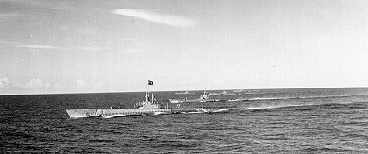 USS Bowfin |
|
http://www.bowfin.org/website/bowfin/sub_facts/sub_facts_frameset.htm |
Pearl Harbour subs were commanded by Rear Admiral Thomas Withers jnr. He ordered his submarines to use sonar attacks as opposed to visual, fine in practise and peacetime, but in the harsh reality of war, a dismal failure. Tautog was the first submarine to see WW2 action, whilst still moored at Pearl, shooting down an enemy fighter when the Duty Officer, William Sieglaff, directed sailors manning a .50 calibre machine gun, manned by Torpedoman's Mate Pasqual Mignon. On December 10th John Wilkes formally assumed command of Submarines Asiatic Fleet. Both Withers and Wilkes were scathing in their reports on sub commanders who consistently returned to base with zero results. This was due in the main to the total ineffectiveness of the Mk 14 torpedo and their insistence on sub commander using an equally ineffective magnetic detonator. Neither worked but Withers and Wilkes refused to accept the evidence before their eyes, blaming it all on bad training and commanders. Many early US Submarine captains were relieved and replaced. For some reason all attacks were ordered to be carried out underwater and not using periscopes!! Patrol after patrol came home empty handed, or with claims that never happened. Many torpedoes detonated prematurely, giving a diving submarine captain the impression that it was a hit. Many were dudes but the vast majority were running too deep, deeper than the actual settings given but every time complaining Captains were overruled. Those Captains that, unofficially, and secretly, discarded the magnetic detonator and reset torpedoes shallower, got some results but the crew were sworn to secrecy and the Commanders of the submarines continued to go on and on about good crews, bad crews etc. Neither of these even had a true idea of what submarines they were ordering to where and when. One such incident saw a submarine, full of escaping personnel, ordered to attack shipping. Instead of arguing the sub captain did as he was told, with the inevitable counter attack and a submarine full of terrified people. |
|
|
|
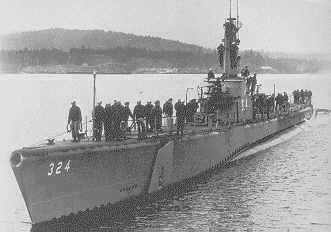 USS Blenny |
Built by Electric Boat and commissioned July 27, 1944, Blenny was one of 195 Balao class submarines. The main difference between the Balao and Gato class boats was the thickness of the pressure hull. Gato boats had 11/16-inch plate, 27.5 pounds per square foot hulls, as compared to the Balao's more robust 7/8-inch, 35 pounds per square foot. Consequently, the Gato boat's safe diving depth was three hundred feet; the Balao boat's was an additional 100 feet, for four hundred feet maximum. Frank Toon, served aboard Blenny and sent me the following urls: |
 Image: Frank Toon USS Blenny |
The following is
Pat Mignone, who is credited with shooting down the first jap plane of WW2. from
the decks of Tautog, in Pearl Harbour.
My thanks to Frank Toon, one of Blenny's heroic sailors of the Pacific war, for
the image. Pat became COB on Blenny.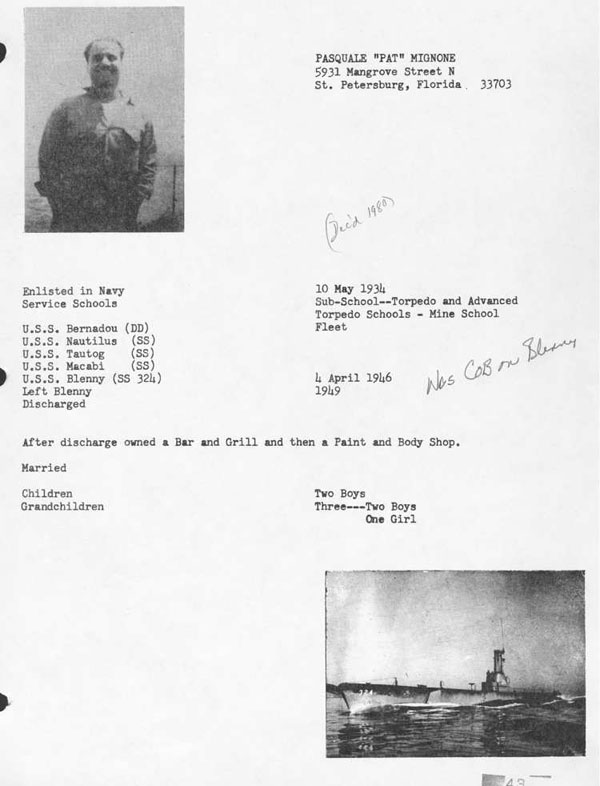 |
|
MK 14 Torpedo
|
|
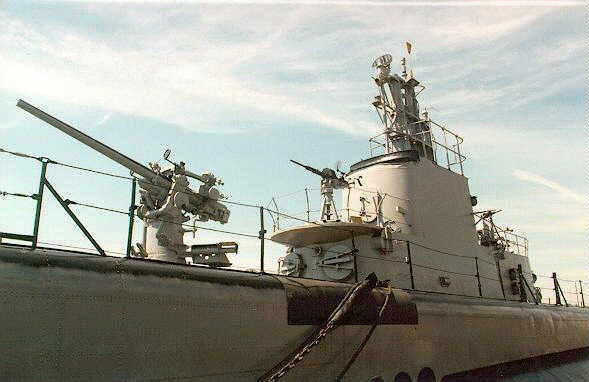 USS Cobia |
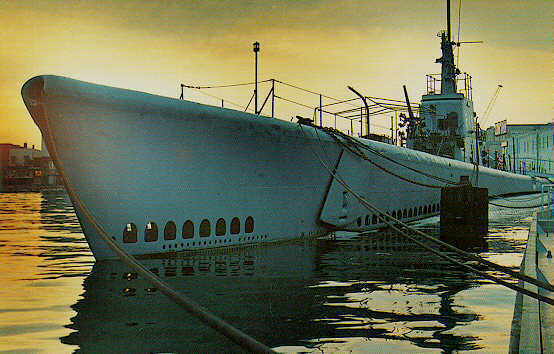 USS Cobia |
|
USS Silversides I am very grateful to Joseph Bostic for the images of USS Silversides right & below: |
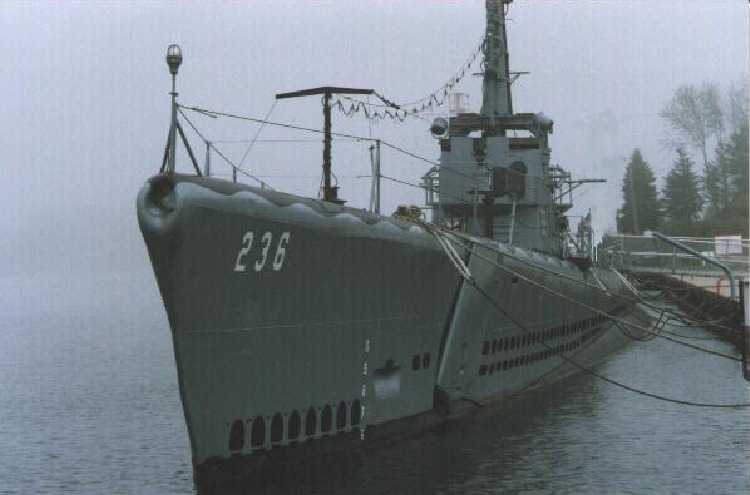 |
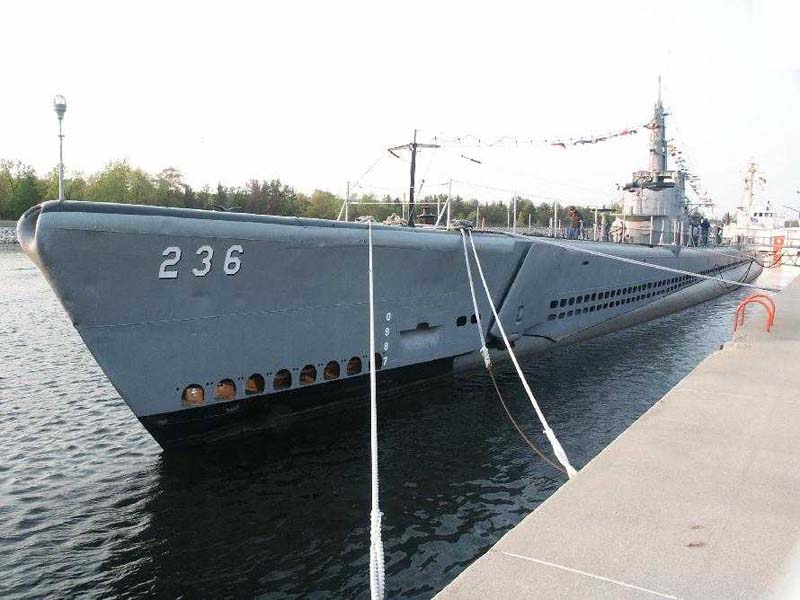 |
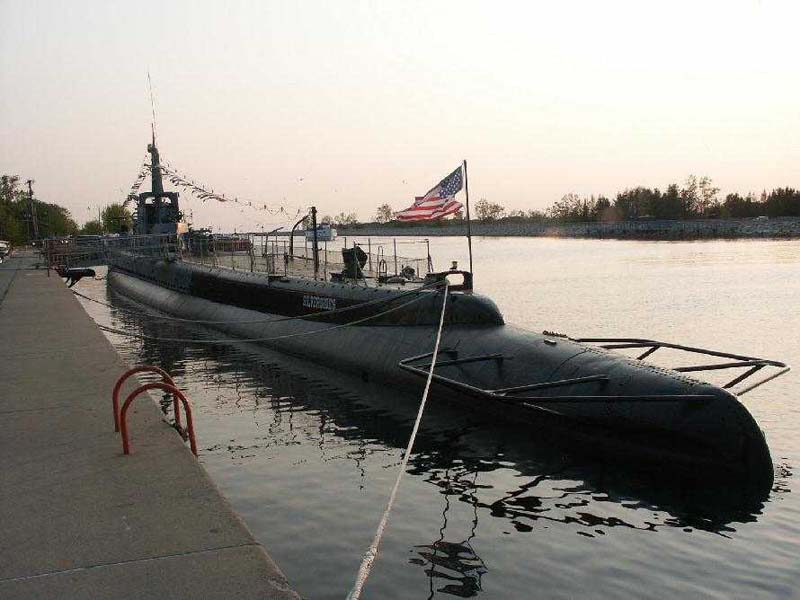 |
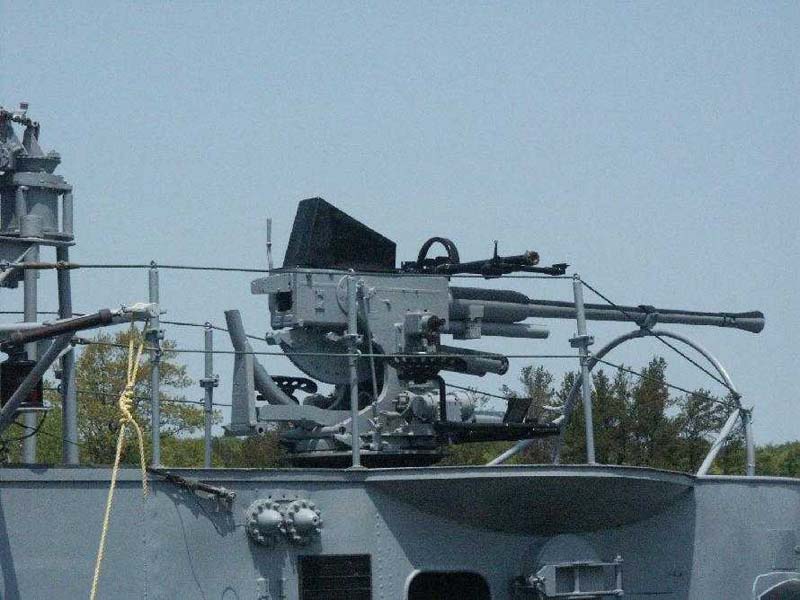 |
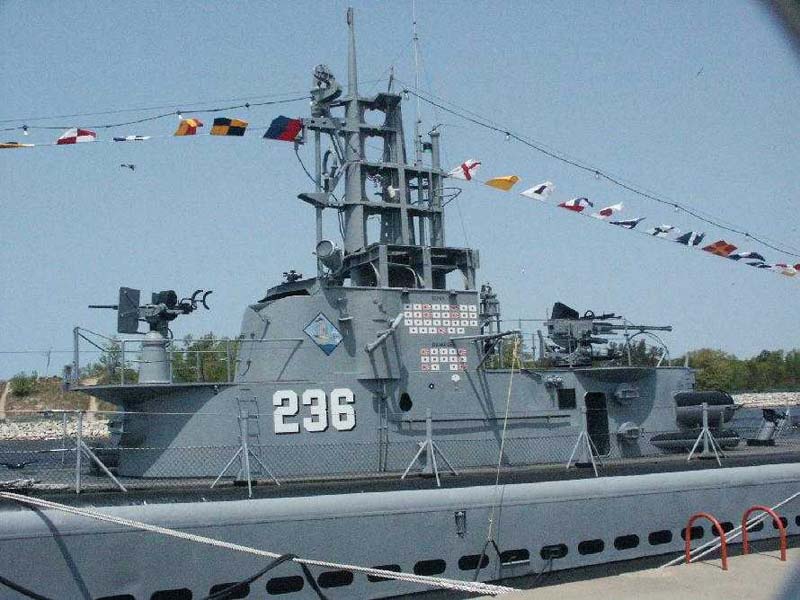 |
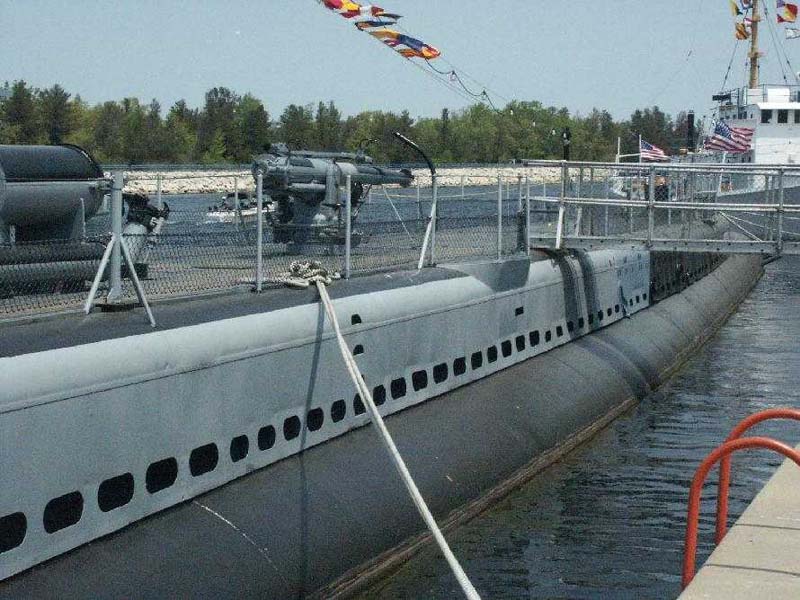 |
Class:
Gato Submarine
Length: 311 feet, 8 inches
Address:
|
| USS Silversides was launched at Mare Island Naval Yard, California, on August 26, 1941. She is a fleet-type submarine (built to maintain fleet speeds averaging 17 knots) of the Gato (Drum) class. In the conflict against Japan in World War II, the role and importance of the submarine forces of the United States cannot be overestimated. American submarines sank more than 600,000 tons of enemy warships and more than 5,000,000 tons of merchant shipping, thus destroying much of Japan's ocean commerce. This was accomplished by a force that never numbered more than two percent of naval personnel engaged in the war. The American submarine war against Japan created a blockade that denied her the oil, iron ore, food, and other raw materials she needed to continue to fight. By 1945 this submarine war made it impossible for any Japanese ship to sail the ocean. Without this commerce and the raw materials it supplied to her war effort, Japan found it impossible to continue the war outside of the homeland. No other WWII submarine remains that sank more ships than the USS Silversides. |
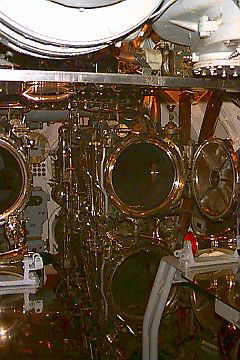 |
|
|
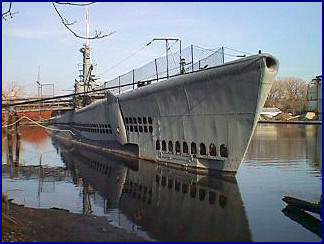 |
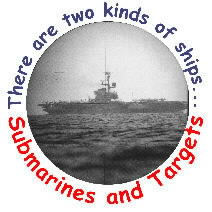 |
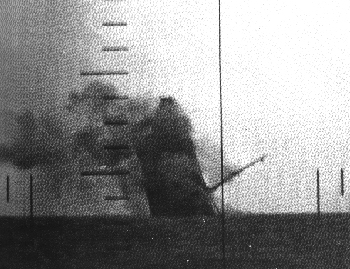 |
|
World War 2 saw some
incredible "scores" by US subs, considering the size of the Pacific.
Here are some of the tonnages sunk by US subs. Submarines got 54.64%
of the war total of Japanese Merchant tonnage sunk. Blenny: sank 63 trawlers, sampans and other small craft by gunfire on ONE patrol.  Bulgara: sank 57 small craft by gunfire on ONE patrol. Cobia: engaged three samll armed vessels in a running gun battle. After slight damage when one of them rammed her, she sank all three of her attackers. Tigrone: Hold record of 31 airmen rescued. Sealion: Found and rescued Sgt B Grier after he had drifted in the China Sea for 23 days. Narwhal: Arrived back in Brisbane carrying 6 men and women and 14 children, rescued from Negros Isleand. She flew 12 clean diapers (nappies) from her mast. Click on sub for Narwhal page. Bluegill: Put a landing party ashore on Pratas Island and "captured it", 160 miles se of Hong Kong. Tautog: First to shoot down enemy plane - at Pearl Dec 7th 1941. Grenadier: Sank transport off Kyushu. Ship carried scientists and technicians.  Tang Tang: Sank 33 (verified) ships, over 100,000 tons. Sank herself when malfunctioning torpedo circled and hit. She settled in 180 feet of water. See below. Tautog: Sank 26 ships. Seawolf: Sank 18 ships and damaged 21 others. Barb: Sank 17 ships. Thresher: Sank 17 ships. Seahorse: Sank 19 ships. Greenling: 26 attacks, 12 patrols and sank 15 ships. Flasher: In tonnage sank more than any other, 103,231 tons. Pogy: 16 ships. 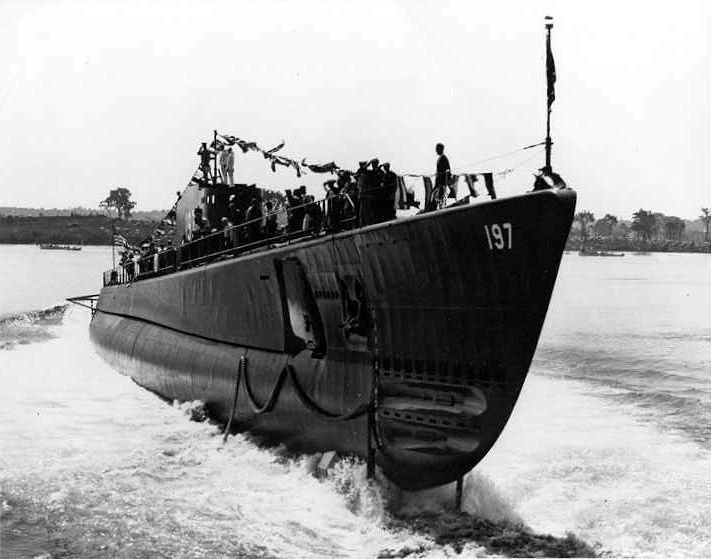 Seawolf Dorado and Seawolf were sunk by "friendly" fire. Grayling Grayling was attacked by a squadron of B17's who reported that they had sunk an enemy cruiser! Sea Robin had a full load of bombs dropped on her by a B-29, they missed by half a mile! |
|
|
The largest ship ever sunk by a submarine was the Japanese aircraft carrier Shinano, sunk by the USS Archerfish. This is apparently still a record today. |
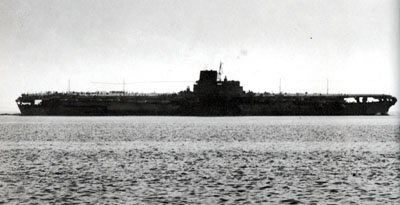 |
 |
The following pages reflect the "official" sinkings and "unofficial" hits, sinkings and damage assessments to enemy ships from SORG's (Submarine Operation Research Group) compilation of submarine attacks at the end of the war. Many ships reported sinkings but these were not confirmable from Japanese records so are not included. Also ships sunk or damaged by several subs or combinations of submarine and aircraft or ship are not reported. Likewise if a ship was less than 500 tons burden it wasn't included in the total. Many times a ship was torpedoed and the crew ran it up on a beach. It didn't "sink" but you can still see the hulks today. The US doesn't credit those either even though the ship was out of the war as effectively as if it had been sunk. |
| When the war ended on August 15th 1945, submarines encircled Japan and the US Third Fleet stood at the entrance to Tokyo Bay. Admiral Yamamoto C in C of Japanese Fleet said at the outset of war, "In the first six months of this war with the United States, I will run wild and win victory after victory. After that, I have no expectation of success". | |
| email: I just visited your website on submarines. It is very good. I was pleased to see a picture of the SS199 Tautog. This sub was also credited with shooting down the first Jap plane of the war. The gun from the Tautog that shot down the plane a single 40mm is sitting outside of the VFW post in Manistee, MI. The deck gun from the sub was donated to the Manistee Clan Muzzle Loading Club who displayed it for years. We got a call from the National Maritime Museum who found out we had that deck gun and wanted it for a sub they restored and have on display in San Francisco. The gun was a long range 4"X 54 which was used to shell the Japan mainland during sneak attacks. The Sub was sold to John Bultema of Bultema Dock and Dredge Co, brought into Manistee Mi. and dismantled. A sorry end to a great ship. Henry Rozmarek. March 2003. | Email: I just found your web site - my grandfather died in 1998 he was in WW2 on several subs in the pacific his job was to show the subs in the pacific fleet how to use the acoustic torpedo. He told me when I was a kid that the Germans invented the acoustic torpedo but they couldn't get it to work right; theirs was armed as soon as it left the sub. We took it & modified it setting it to arm at 1000 yards my family & I are right now waiting for his records from the navy because he was supposed to get a medal he never received. I saw a letter he showed me from the President Truman thanking him for his top secret work on the torpedo I'm trying to get a copy of that also for my grandmother who is still alive hopefully I will be able to get these things I love the pics you have & wonder if he is in one of them you never know any way I'm glad that there are sites like yours & I know he would of loved it. His name was PHILIP J PIRONE if you know any web sites that could help us please let me know. Thank You Mike Wilkens. March 2006. wilky9962 - at - verizon.net for direct contact if you have info for him. Delete - at - with @ to call him. |
|
Note on the USS Tang: During World War II most submarine officers agreed that any thought of escape in wartime was a waste of effort, and they resented the escape equipment that took up precious space aboard their craft. Submarine attack forces roamed far and wide, and often at depths from which any form of escape would be impossible. There seemed to be little point in thinking about survival after a sinking. Fifty-two American submarines were lost during the war. Most of them disappeared without a trace. The only known escape was made following the sinking of the USS Tang, in October 1944. In the midst of a surface attack on a Japanese transport, one of two torpedoes fired by the Tang boomeranged, veering back to hit the submarine. The Tang’s stern sank to the bottom, 180 feet down, and sat there at an acute angle for about fifteen minutes, long enough for one officer who found himself in a pocket of trapped air in the conning tower to escape. He left through the hatch wearing neither breathing apparatus nor life belt. Remembering his experience with free ascent while in submarine school, he exhaled as he rose sixty feet to the surface. He was able to swim about for eight hours before being picked up. Over the next six or seven hours, the remaining men on the Tang made some four attempts to escape. The effects of building pressure in the submarine and foul air were both physically and mentally debilitating and kept many of the men from even contemplating action. Thirteen of them got out of the submarine, however, some using lungs, and eight or nine made it to the surface alive. Five survived. They were the only survivors out of more than thirty-five hundred Americans lost in submarines sunk during World War II. One of the men was very close to passing out from a shortage of oxygen when he lost the mouthpiece of his lung about twenty feet from the submarine. “When I lost my lung,” he said later, “I blew the air out all the way to the surface trying to equalize the escaping air the way the lung would have done. On reaching the surface I was exhausted and sick.” He got to a life buoy nonetheless and was picked up about four hours later. |
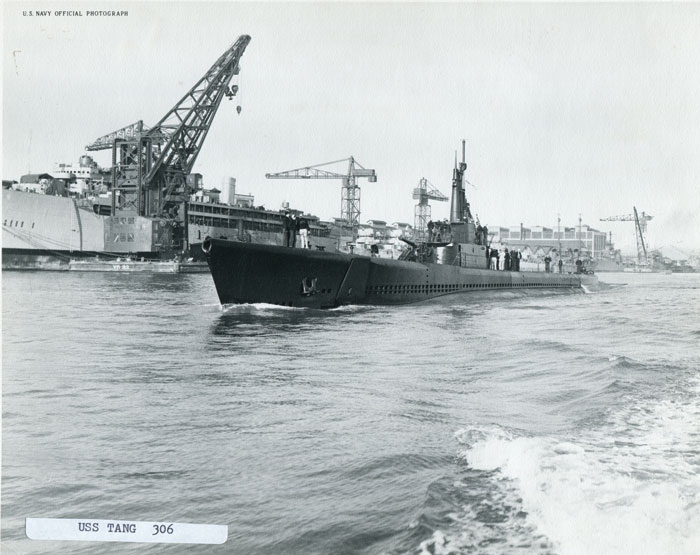 https://www.youtube.com/watch?v=iqu_gkKCNSo a tribute |
| October 2007. Don Near contacted me from Ontario. Amongst other things he told me he had made a model of the Gudgeon. I asked him for some images, here they are. |
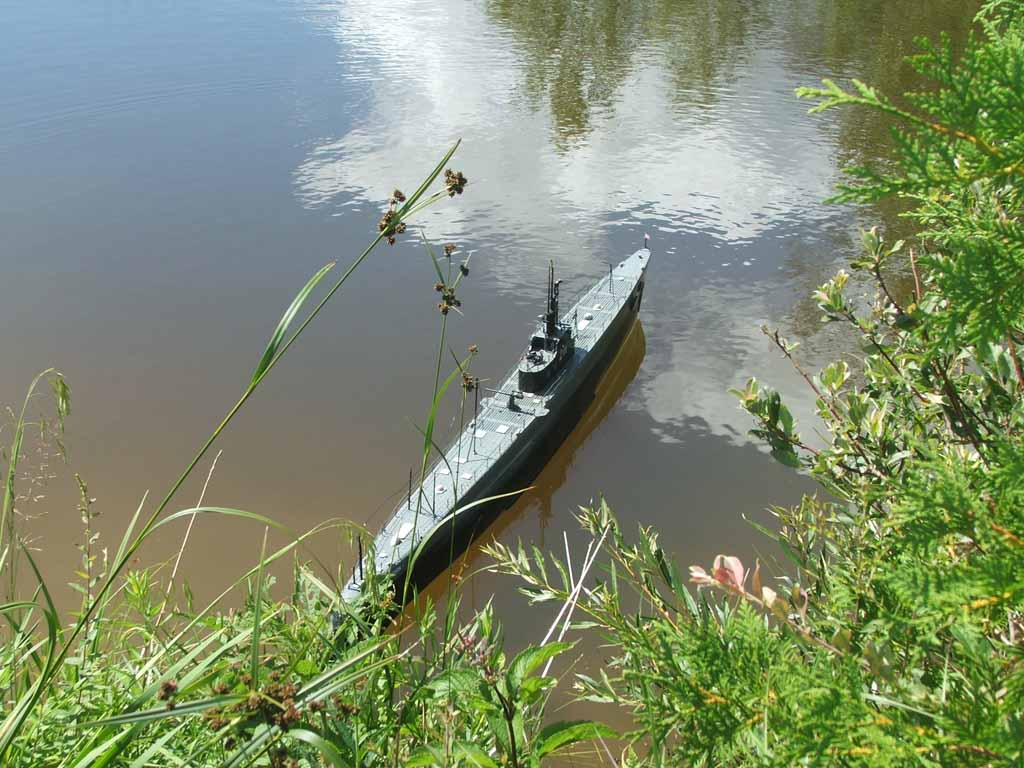 |
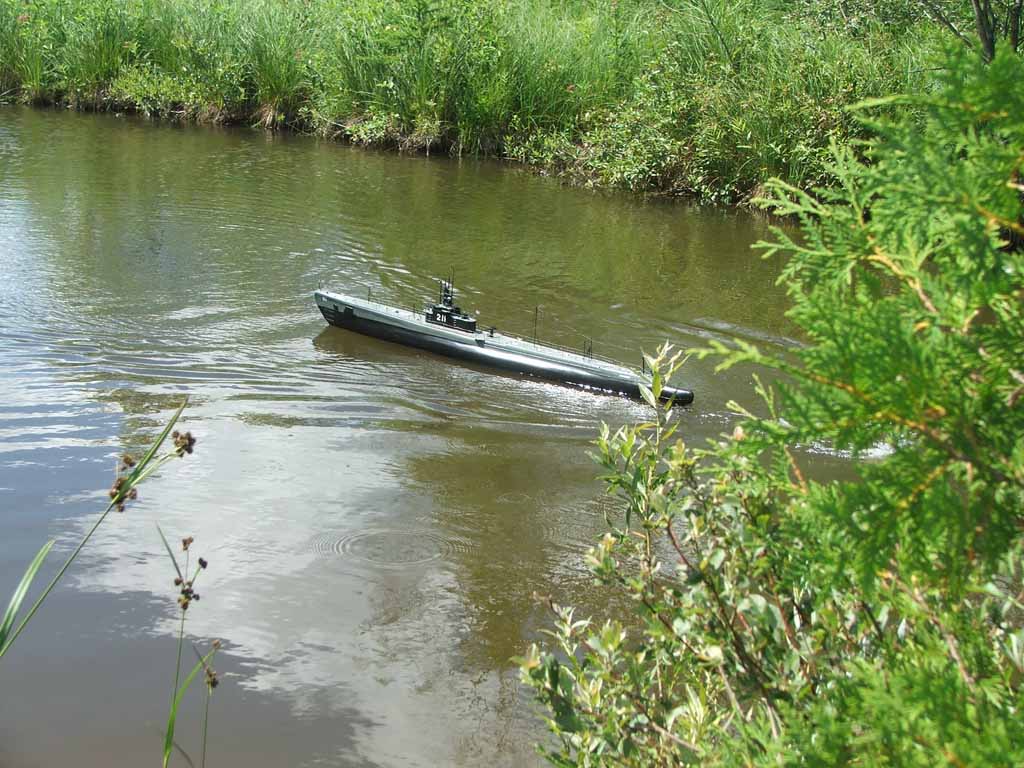 |
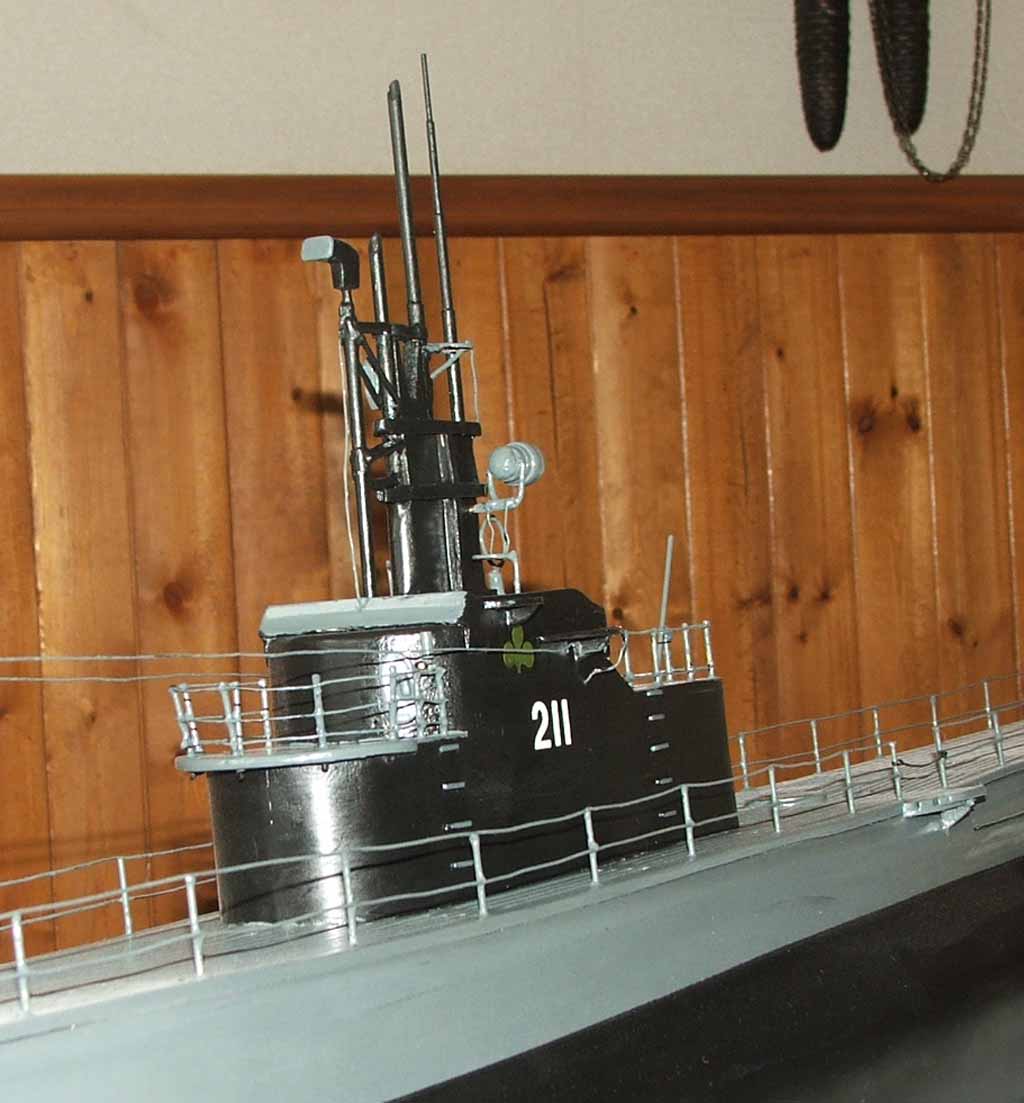 |
 |
|
| SPECIFICATIONS Overall Length x Maximum Breadth: 298 ft. 1 in. x 25 ft. 1 in. Displacement: 1,316 tons Surfaced; 1,968 tons Submerged. Operating Depth: 250 feet. Watertight Compartments: 7 plus conning tower. Pressure Hull Plating: approx. 5/8 in. mild steel. Torpedo Tubes: 4 bow; 2 stern. 2 bow deck tubes added to SS 175 in 1942. Torpedo Load, Max: 16, 18 with deck tubes. Deck Guns: 1 3-in./50-cal. Maximum Speed: 18 knots surfaced; 8 knots submerged. Cruising Range: 11,000 miles surfaced at 10 knots. Submerged Endurance: 36 hours at minimum speed. Fuel Capacity: 85,946-86,675 gallons. Patrol Endurance: 75 days. Propulsion: Diesel-electric reduction gear with 4 main generator engines, 2 aux. generator. 4 main motors with 4,300 shaft horse power. 2 120-cell main storage batteries. CONSTRUCTION: Number of boats: 2 boats ordered in 1934. Builders: Electric Boat | |
 |
|
| SPECIFICATIONS Overall Length x Maximum Breadth: 308 ft. x 26 ft. 2 in. Displacement: 1,449 tons Surfaced; 2,198 tons Submerged. Operating Depth: 250 feet. Watertight Compartments: 7 plus conning tower. Pressure Hull Plating: approx. 11/16 in. mild steel. Torpedo Tubes: 4 bow; 4 stern. Torpedo Load, Max: 20 internal, 4 external (later removed) Deck Guns: 1 3-in./50-cal. Maximum Speed: 17 knots surfaced; 8.75 knots submerged. Cruising Range: 11,000 miles surfaced at 10 knots. Submerged Endurance: 48 hours at 2 knots. Fuel Capacity: 96,025 gallons. Patrol Endurance: 75 days. Propulsion: Composite with 2 main propulsion engines, 2 main generator engines, 2 aux. generator engines. 4 main motors with 2,660 shaft horse power. 2 126-cell main storage batteries. CONSTRUCTION: Number of boats: 6 boats ordered in 1936. Builders: Electric Boat (SS 182-184); Portsmouth (SS 185,186) Mare Island (SS 187) | |
 |
|
| SPECIFICATIONS Overall Length x Maximum Breadth: 310 ft. 6 in. x 27 ft. 1 in. Displacement: 1,460 tons Surfaced; 2,350 tons Submerged. Operating Depth: 250 feet. Watertight Compartments: 7 plus conning tower. Pressure Hull Plating: approx. 11/16 in. mild steel. Torpedo Tubes: 4 bow; 4 stern. Torpedo Load, Max: 20 internal, 4 external (later removed) Deck Guns: 1 3-in./50-cal. Maximum Speed: 20 knots surfaced; 8.75 knots submerged. Cruising Range: 11,000 miles surfaced at 10 knots. Submerged Endurance: 48 hours at 2 knots. Fuel Capacity: 109,000 gallons. Patrol Endurance: 75 days. Propulsion: Composite with 2 main propulsion engines, 2 main generator engines, 2 aux. generator engines. 4 main motors with 2,740 shaft horse power. 2 126-cell main storage batteries. CONSTRUCTION: Number of boats: 6 boats ordered in 1937. Builders: Electric Boat (SS 188-190); Portsmouth (SS 191,192) Mare Island (SS 193) | |
 |
|
| SPECIFICATIONS Overall Length x Maximum Breadth: 307 ft. 3 in. x 27 ft. 3 in. Displacement: 1,475 tons Surfaced; 2,370 tons Submerged. Operating Depth: 250 feet. Watertight Compartments: 7 plus conning tower. Pressure Hull Plating: approx. 11/16 in. mild steel. Torpedo Tubes: 6 bow; 4 stern. Torpedo Load, Max: 24 Deck Guns: 1 3-in./50-cal. Maximum Speed: 20 knots surfaced; 8.75 knots submerged. Cruising Range: 11,000 miles surfaced at 10 knots. Submerged Endurance: 48 hours at 2 knots. Fuel Capacity: 93,993-96,365 gallons. Patrol Endurance: 75 days. Propulsion: Diesel-electric reduction gear with 4 main generator engines, 2 aux. generator. 4 main motors with 2,740 shaft horse power. 2 126-cell main storage batteries. CONSTRUCTION: Number of boats: 12 boats ordered in 1939-1940. Builders: Electric Boat (SS 198-200; 206-208), Portsmouth (SS 201,202, 209,210), Mare Island (SS 203, 211) | |
 |
|
| SPECIFICATIONS Overall Length x Maximum Breadth: 311 ft. 9 in. x 27 ft. 3 in. Displacement: 2,025-2,060 tons Surfaced; 2,424 tons Submerged. Operating Depth: 300 feet. Watertight Compartments: 8 plus conning tower. Pressure Hull Plating: approx. 11/16 in. mild steel. Torpedo Tubes: 6 bow; 4 stern; max load = 24 Deck Guns: 1 3-in./50-cal. Maximum Speed: 20.25 knots surfaced; 8.75 knots submerged. Cruising Range: 11,000 miles surfaced at 10 knots. Submerged Endurance: 48 hours at 2 knots. Fuel Capacity: 94,400 gallons. Patrol Endurance: 75 days. Propulsion: Diesel-electric reduction gear with 4 main generator engines, 1 aux. generator. 4 main motors with 5,400 shaft horse power. 2 126-cell main storage batteries. CONSTRUCTION: Number of boats: 77 boats ordered between 1941 and 1943. Builders: Portsmouth (SS 275-280, 228-235); Manitowoc (SS 265-274, 361-364); Electric Boat (SS 212-227, 240-264); Mare Island (SS 236-239; 281-284) | |
 |
|
| SPECIFICATIONS Overall Length x Maximum Breadth: 311 ft. 9 in. x 27 ft. 3 in. Displacement: 2,010-2,075 tons Surfaced; 2,415 tons Submerged. Operating Depth: 400 feet. Watertight Compartments: 8 plus conning tower. Pressure Hull Plating: approx. 7/8 in. high tensile steel. Torpedo Tubes: 6 bow; 4 stern; max load = 24 Deck Guns: 1 4-in./50-cal. or 1 5-in./25-cal. Maximum Speed: 20.25 knots surfaced; 8.75 knots submerged. Cruising Range: 11,000 miles surfaced at 10 knots. Submerged Endurance: 48 hours at 2 knots. Fuel Capacity: 116,000 gallons. Patrol Endurance: 75 days. Propulsion: Diesel-electric reduction gear with 4 main generator engines, 1 aux. generator. 4 main motors with 2,740 shaft horse power. 2 126-cell main storage batteries. CONSTRUCTION: Number of boats: 256 boats ordered between 1942 and 1945. 119 completed. Builders: Portsmouth (SS 285-291, 308-312, 381-410); Manitowoc (SS 361-369); Electric Boat (SS 313-352, 370-378); Mare Island (SS 304-307; 411-416); Cramp (292-295; 297-303) | |
 |
|
| SPECIFICATIONS Overall Length x Maximum Breadth: 311 ft. 8 in. x 27 ft. 3 in. Displacement: 1,980-2,000 tons Surfaced; 2,415 tons Submerged. Operating Depth: 400 feet. Watertight Compartments: 8 plus conning tower. Pressure Hull Plating: approx. 7/8 in. high tensile steel. Torpedo Tubes: 6 bow; 4 stern; max load = 28 Deck Guns: 1 or 2 5-in./25-cal. Maximum Speed: 20.25 knots surfaced; 8.75 knots submerged. Cruising Range: 11,000 miles surfaced at 10 knots. Submerged Endurance: 48 hours at 2 knots. Fuel Capacity: 118,510 gallons. Patrol Endurance: 75 days. Propulsion: Diesel-electric direct with 4 main generator engines, 1 aux. generator. 2 main motors with 5,400 shaft horse power. 2 126-cell main storage batteries. CONSTRUCTION: Number of boats: 80 boats ordered between 1943 and 1946, but only 26 completed. Builders: Portsmouth (SS 417-424, 475-489); Cramp & Sons (SS 425); Electric Boat (SS 435); Boston (SS 522) | |
 |
|
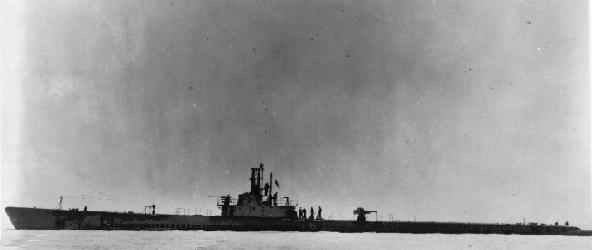 USS Skate See page 3 for her sad fate |
|
| In memory of those who did not return and those who did, but have passed on. Heroes all | |
| Grayback: The grayback was sunk by a Jap aircraft, hitting it with a 500lb bomb, no survivors. However the location given was incorrect and the Gar class Grayback has now been found, just off Okinawa. It was sunk on 27 Feb 1944. Here is a link to the new information. I dont know what is worse, a site that has its 'historical' information all wrong or there is no means of contacting the authors, eg: no contact link. One such is fleetsubmarine.com; their info on Grayback seems to be all guesswork. Over the years I have found several web sites, all american, who are wrong in various aspects. | |
| https://www.nytimes.com/2019/11/10/us/navy-submarine-missing-for-75-years-is-found-off-okinawa.html | |
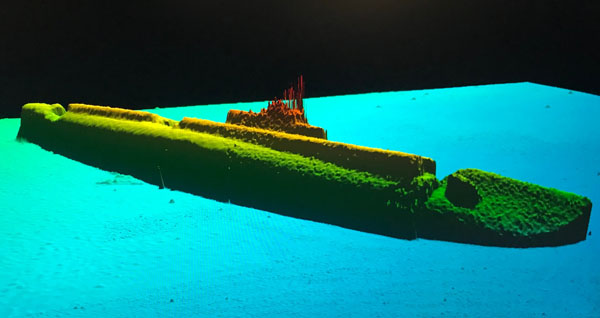 sonar image of Grayback from the above mentioned source. |
|
Compare this video with the boats on these pages - the amazing USS Pennsylvania http://www.youtube.com/embed/UxB11eAl-YE#t=21
https://mesothelioma.net/mesothelioma-and-veterans
Must watch: https://www.youtube.com/watch?v=YQ4KmpdHUVs Silent Hunter Documentary
In Memory - Capt Zeb Alford USN
http://navy.togetherweserved.com/usn/servlet/tws.webapp.WebApps?cmd=PublicProfile&type=Person&ID=481678
http://www.youtube.com/watch?v=MUoAdVakmDU&feature=digest - Caswell Foxtrot Operational model
http://www.mesotheliomaprognosis.net/
![]()
https://www.mesotheliomafund.com
http://www.ibiblio.org/phha/Narwhal.html
http://www.fact-index.com/u/us/uss_trigger__ss_237_.html
http://www.bowfin.org/website/bowfin/bowfin_history/patrols/p_4/patrol_4.htm
http://www.brainyencyclopedia.com/encyclopedia/g/ga/gato_class_submarine.html
https://www.nytimes.com/2019/11/10/us/navy-submarine-missing-for-75-years-is-found-off-okinawa.html
http://www.history.navy.mil/faqs/faq11-1.htm
http://www.ussbatfish.com/batfish-main.html
http://www.submarinesailor.com/CrewCountByBoat.asp
There were quite a few links, those that no longer exist have been removed
